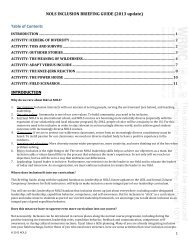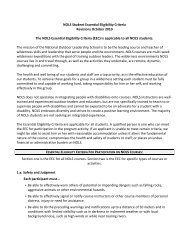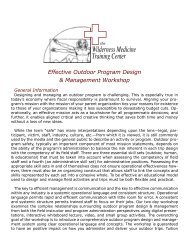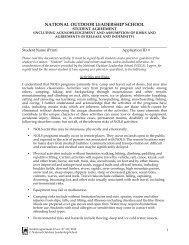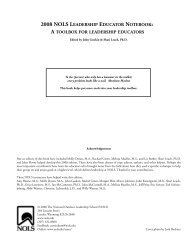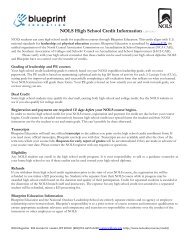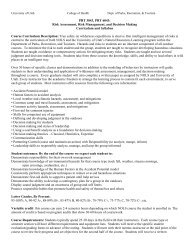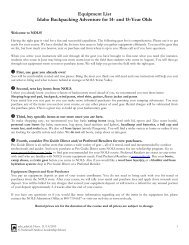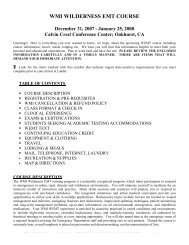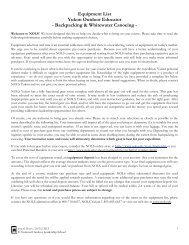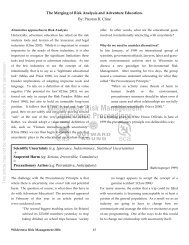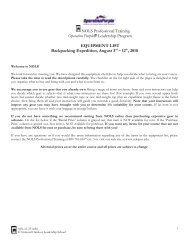2013 Inclusion Briefing Guide (pdf) - NOLS
2013 Inclusion Briefing Guide (pdf) - NOLS
2013 Inclusion Briefing Guide (pdf) - NOLS
You also want an ePaper? Increase the reach of your titles
YUMPU automatically turns print PDFs into web optimized ePapers that Google loves.
ACTIVITY: ICEBERG OF DIVERSITYAdapted from the U.S. Peace Corps World Wise Lesson Plans and the “I Am” activity in 52 Activities for Exploring Values Differences, Donna Stringer and Patricia Cassiday (2003) Say: “DIVERSITY connotes the unique differences between us. INCLUSION is what we do to welcome people who are different from us. DIVERSITY is what we are. INCLUSION is what we do. Remember inclusion is not just respect or tolerance—it’s welcoming differences, which is more than just tolerance.” Ask: “What does it feel like to be tolerated?” (usually it’s not positive) Ask: “How are we all different from each other?” As students contribute, write it down on a board. Put the visible stuff (race, age, appearance, etc.) toward the top of the board, and the invisible stuff (religion, values, sexual orientation) toward the bottom. Then draw an iceberg around all the words and a waterline between the visible and invisible (like below). Point out some important things: • “Just 90 percent of an iceberg is below the surface, 90 percent of who you are is below the surface.” • “Even in a visually homogeneous group (e.g., all Caucasian American boys), there is diversity. You just have to look below the surface.” • “Some dimensions of diversity are sometimes found above and sometimes below the water line—like gender”(explore why this might be the case). Now have each person introduce himself or herself to another person using five descriptors under the water line. Tell students they don’t need to limit their introductions to what is on the board—just five important and defining things that they want their partner to know about them that they wouldn’t know just by looking at them (invisible characteristics). Debrief: “Any surprises? What would happen if you didn’t know the below-‐the-‐waterline traits about someone you live with, cook with, and sleep next to? How can you find out more about these characteristics?” Conclude: “Imagine each of us is an iceberg floating around. Other icebergs in our group only see what is above the surface, and it is very easy for them to make assumptions about the stuff below the surface (for example, someone might see our clothing and make assumptions about our wealth). The problems occur when these assumptions are wrong—and icebergs end up colliding under the water. We cannot avoid icebergs colliding, but we can try to become more aware of other icebergs so we can minimize the number of collisions that happen. This takes having conversations like the one we just had with each other.” ACTIVITY: TOSS AND SURVIVEThis activity is super fun and active. It works well with rolled up socks (preferably clean!) or snowballs. Have the group circle up. Each person gets two balls. Say: “You each have two balls in your hands. If a ball hits you, you die. The goal of this activity is to be alive at the end of 30 seconds. Go!” Now count to 30 seconds out loud and you’ll probably see an all-‐out snowball fight. If that happens, do it again and again until the group realizes that the best way to survive is for nobody to throw their balls. Debrief: • “To Those who immediately attacked, why did you do it?” • “To those who ran away, why did you do it?” • “To those who held their balls, why did you do it, and what did it feel like to not throw them?” • “What were your assumptions about this game?” (Usually, assumptions include that the game was competitive, that it meant there were winners and losers, and that folks couldn’t collaborate or communicate) Conclude: “This is the ultimate metaphor for inclusion. Think of these balls as things we do that make people feel excluded. Imagine how much more inclusive it would be if you didn’t react based on a knee-‐jerk and hurl your snowballs. Then everybody could win!” This document may not be reproducedwithout the consent of the author. 10/13© <strong>2013</strong> <strong>NOLS</strong>2
ACTIVITY: OUTSIDER STORIESAdapted from activity presented by Executive Diversity Services at a 2006 “Train-‐the-‐Trainer” workshop Say: “Sometimes the only way to truly understand what a word like ‘inclusion’ means is to figure out what it doesn’t mean.” Ask: “What is the opposite of inclusion? (Exclusion!) “So now we’re going to explore what it feels like to be excluded.” Break into small groups of 3-‐4. Say: “Share the story of a time you felt like an outsider. Talk about (1) what it looked/sounded like (from the perspective of a fly on the wall observing the situation) (2) what it felt like (both emotionally and physically, e.g., if you felt a knot in your stomach), and (3) how you responded to it.” (Write the three categories on a board so they remember) Have each group report to you after about 10 minutes and list all the words that crop up under three categories. Your list will look something like this. Looks/sounds:• a circle ofpeople withme outside it• peoplespeaking adifferentlanguage• peoplewhisperingand looking atme funnyFeelings• knot in mystomach• frustrated• lonely• confused• sad• angryResponse• ran away• became morefriendly• assimilated• lashed outDebrief: • Ask: “What can you say about the looks and sounds of these outsider stories?” (discuss) Conclude: “The looks and sounds of exclusion are typically subtle and people usually don’t intend to make you feel like an outsider. These behaviors are what we call microaggressions—things we do that unintentionally exclude others. Example of microaggressions are: • “Where are you really from?” • “Your English is so good!” • “That’s so gay” or “quit being such a fag!” • “Man up!” or “Sack up!” or “Grow a pair!” • Caricaturizing cultural groups (e.g., a “Kung Fu” accent to teach a bow strokes class) • Sarcasm (this is a norm for American communication styles—but point out that the origin of the word is sarkasmos, which is the Greek word for “tearing or rending of the flesh.”) • Ask: “What can you say about the feelings of being an outsider?” (discuss) Conclude: “The feelings are quite profound and deep. Distinguish intent versus impact here—the intent might be innocent, but the impact is negative.” • Ask: “What can you say about your responses to the outsider situation?” Conclude: “Reactions/responses usually are varied—some people run away and some become very friendly. This means you can never tell by a person’s behavior whether they are feeling like an outsider, so the only thing we can do is ask!” • Ask: “Why did we just do this activity?” Conclude: “By getting you all to reflect on what it felt like to be an outsider, you can build some empathy for others in this group that might be feeling that way too, for completely different reasons.” This document may not be reproducedwithout the consent of the author. 10/13© <strong>2013</strong> <strong>NOLS</strong>3
ACTIVITY: THE MEANING OF WILDERNESSAdapted from Arthur Carhart National Wilderness Training Center, Ninth Grade through Twelfth Grade Curriculum, Social Studies, Historical/Cultural Perspectives, Lesson 6: “Celebrating Our Diversity Through Wilderness”) Have students read the following essay before the activity: Excerpt from: Innu Support and the Myth of Wilderness, By Jennie Baron How do we … connect with and speak about contemporary Aboriginal struggles in the places we visit? To get at this question, first I want to take a deep look at something we often take for granted: the whole notion, or myth, of wilderness. For a brief history of this cultural myth, let me outline an argument given in an essay by environmental historian William Cronon [who] argues that wilderness, “far from being the one place on earth that stands apart from humanity … is quite profoundly a human creation—indeed, the creation of very particular human cultures at very particular moments in human history.” That is to say, when we use the term “wilderness,” the meaning that comes to mind is distinctly Euro-‐American and relatively recent in the history of ideas. As Cronon notes, if we look back a mere 250 years in North American and European history, we do not find people wandering around remote corners of the planet looking for the “wilderness experience.” He says it’s not that they couldn’t do so; they didn’t want to, for wilderness didn’t mean to them what it does to us today. As late as the 18th century, the most common use of the word “wilderness” in the English language had to do with landscapes also described as desolate, savage, or a wasteland. According to Cronon, the connotations of wilderness were nothing like they are today; if you found yourself there, you would likely have found yourself feeling bewildered or terrified, hardly at peace with the universe. The wilderness was a place you went only against your will, in your darkest hours of fear. It was the antithesis of all that was orderly and good. By the end of the 19th century, Cronon writes, the meaning of wilderness had been turned on its head. This is when we find Thoreau declaring, “in wildness is the preservation of the world.” This is when the North American public is starting to see in the wild spaces on their map a little piece of heaven on Earth. Yosemite and Yellowstone are declared the first American wilderness parks, and in the first decade of the 20th century we see the emergence of the movement to actually protect wilderness. Cronon writes, “In a mere fifty years, Satan’s home had become God’s own temple” (1996, p. 72). How did that happen? Cronon cites two influential and pervasive cultural constructs: the romantic notions of the sublime and the frontier. The doctrine of the sublime derived from the theories of people like Edmund Burke and Immanuel Kant. According to them, sublime landscapes were those where the supernatural lay just beneath the surface, the places where God was most likely to be encountered: on the mountaintop, in the canyon, the waterfall, the thundercloud, the towering forests. Cronon observes that the most popular and celebrated landscapes in North America tend to be sublime landscapes, as are most areas designated as national parks. (It is only recently that we have begun using other criteria—ecological criteria, for example—as a basis for judging and valuing less sublime landscapes, like grasslands or wetlands.) The second cultural construct that helped turn wilderness into a quasi-‐religious icon derives from the romantic attraction to primitivism: “the belief that the best antidote to the ills of an overly refined and civilized modern world was a return to simpler, more primitive living” (Cronon, 1996, p. 76). According to Cronon, this European ideal of the primitive was embodied in [North] America through the myth of the frontier: the frontier represented not just the edge of “civilization,” but the whole process by which Europeans and easterners moved west, and “shed the trappings of civilization, rediscovered their primitive racial energies, reinvented direct democratic institutions, and thereby re-‐infused themselves with a vigor, an independence, and a creativity that were the source of American democracy and national character” (1996, p. 75). In this way, the frontier—that is, the wilderness—became associated with the very essence of what it meant to be American. In Canada, of course, the frontier myth looks a little different. For one thing, the frontier is to the north more than to the west, in the sense that the North has been more closely associated with our national character and self-‐image. But the mystique and the feelings of longing associated with the lands beyond the frontier are probably just as familiar to a large number of Canadians. The point Cronon makes is that by the early 20th century, wilderness had not only become sacred—that is, imbued with the presence of God—it had also become inseparably associated with our respective national identities. To lose wilderness would be to lose our myth of origin. My reason for giving you all this history of wilderness, of course, is to show just how culturally constructed the idea of wilderness is. “Wilderness” as we understand it today is largely the product of religious, historical, and cultural influences. By association with the sublime, wilderness has come to be sacred; wilderness has also been made more-‐or-‐less synonymous with “emptiness”—it is the place beyond the frontier. Now, it is no accident that we recreational canoeists don’t live in the places we call “wilderness,” because the myth of wilderness is rooted in the idea that for a place to be really natural it must also be virtually pristine. The problem with the myth of pristine wilderness is that it is in many ways an illusion. You probably know that many places we consider pristine are not in fact “pristine.” Historians are just now learning about the © <strong>2013</strong> <strong>NOLS</strong>4 This document may not be reproducedwithout the consent of the author. 10/13
history of modifications and adaptations of the land for human uses—including fire-‐setting, even the domestication of plants in the middle of places we think of as virgin forests. And you may also know that the establishment of the first large “wilderness” parks in the U.S. was made possible precisely by removal of the parks’ original inhabitants! But the fiction of the pristine suppresses this history. This is not just a matter of forgetfulness or even cruel irony. It’s more of a sleight of hand that some would say amounts to racism because representations of the wilderness as empty, unnamed, unmapped territory, as places awaiting discovery and ownership by Europeans have been used historically to dispossess Aboriginal people of lands they have used, travelled, named, and made. So here is where we encounter our contradiction. Many of us are wilderness advocates. We love the stunning places we visit[.] We want to protect them. At the same time, many of us recognize the terrible things that have been done by colonial governments in our name, and want to take part in healing and reconciliation with Aboriginal people. We want to support Aboriginal rights and see Northern people like the Innu regain their health, autonomy, and self-‐reliance, with a fair land base of their own. But when we try to bring together our concerns for both the place and the people of Labrador, we run into problems because the discourse of “wilderness” is highly restrictive when it comes to Aboriginal rights, and human rights in general. I learned this the hard way. In May 1997, I took part in organizing a public talk by Innu leader Daniel Ashini in Toronto. Our group had decided to set the stage for Daniel’s talk by presenting a slide show prepared by another Innu support group in Vermont, who call themselves the Friends of Nitassinan. The slide show came with a prepared script, which gave me great discomfort to read, though I did not at the time understand quite why (nor did I have the knowledge or experience to narrate the slides without a script). After our somewhat stiff and self-conscious presentation of the slides, I got my first clue why I felt so uncomfortable. Daniel Ashini took his place at the microphone and began his talk with words to this effect: Although you may not have seen it in those pictures, there are people living in Nitassinan. Daniel’s comment was brief and tactful, but it illuminated in a moment the contradiction inherent in the literature of the other support group: They call themselves “Friends of Nitassinan” and yet described their mandate as “Defending Eastern North America’s Last Frontier.” Where notions of the frontier—a fundamental part of the wilderness myth—imply emptiness, the word “Nitassinan,” meaning homeland, implies occupation. So what kind of human occupation can this contradiction allow? In a phrase, romantic primitivism. Sure enough, if we go back to the slide show, we see ample evidence of an effort by the Friends of Nitassinan—however unconscious—to massage Innu reality and objectives so they conform to a romantic primitive image. This was done through their choice of images, as well as through what the script said, and what it failed to say (for instance, the slide show didn’t mention settlers or other Labradorians anywhere). Of 73 slides in the show, only six showed people. The Innu and Inuit were not even mentioned until slide #21, and the mention was indirect, with an image of a caribou skull left hanging in a tree. That skull, and the next slide, which showed ancient tent rings, was presented as “the evidence of the continuing occupation of the land by the Innu and Inuit” (as if that was the only evidence). And the text read: “The Innu and the Inuit are as much a part of the ecosystem as the animals. They have evolved together.” The script overall boiled down to one simplistic message: Save the Innu because they are part and parcel of wild Earth. This is a problem, not only because that message is easily contradicted by the tragic images (gas-‐sniffing youth, etc.) we see on TV and in the papers, but because it is based on the delusional desires of the so-‐called support group more than on the actual goals and realities of those whom they profess to support. And when supporters project those desires onto the Innu, it can lead to major problems. First, this sort of Chief Seattle-‐ization, this romanticization of real people, puts the Innu on a pedestal from which it is impossible not to fall. It creates the expectation that the Innu, or Aboriginal people in general, should live more honourably than we do, and not make the same mistakes. So when Aboriginal people litter, overhunt, log, or build hydro dams, they are doubly condemned: High expectations produce bitter disappointments. The second problem with this kind of representation is that it perpetuates the idea that Aboriginal claims to the land are only legitimate if Aboriginal people continue to live as their ancestors did 100 years ago. This is a silly expectation to have of any ethnic group. In fact, opponents of the Innu have used this way of thinking to argue against Innu land rights by claiming that the Innu are no longer “traditional” because they take planes to their hunting territories and take along store-‐bought food. This is an idea supporters have to challenge, in the name of fairness, pragmatism, and the right of the Innu to self-‐determination. We have to learn to see tradition not as stasis, or preservation of a thing or technique, but more as the thread of continuity that links past, present, and future in a dynamic flow. Moreover, the continuation of traditional life in the modern day is often, in fact, enabled by planes, radios, Ski-‐Doos, and other modern means. Perhaps the biggest problem with the discourse on “wilderness” . . . is that the idea of wilderness leaves precisely nowhere for real people to live permanently inside its boundaries, and no way for them to make a living. This may be where it’s hardest for supporters to reconcile their environmental priorities and their wish to support Innu self-‐determination. It’s not that the political goals of environmentalists and Innu are fundamentally incompatible; many Innu themselves choose to speak as protectors of the land, and they choose to work with environmental groups as allies. No, the problem with such Aboriginal-‐environmental alliances is more that it’s too easy to assume that our issues and goals are the same, or at least more similar than they really are. Consequently, © <strong>2013</strong> <strong>NOLS</strong>5 This document may not be reproducedwithout the consent of the author. 10/13
those who insist on seeing Nitassinan as that last-‐chance place to preserve wild Earth are often shocked and dismayed if and when the Innu decide it’s in their best interest to embark on joint ventures, engage in forestry, or benefit from a mine. Even if those developments are carried out in ecologically and socially responsible ways, many environmentalist supporters often can’t bring themselves to support them. This is not to say that the Innu do not have a special culturally-‐rooted relationship to the land. But in my experience, when Innu speak about their concerns for the land, they do so not as primitives or innocents in the wilderness, but as participants in a peopled and productive landscape. Their concerns for the land and animals are inseparable from their concerns for their health, and their way of life—that is, life in the country, or nutshimit. (Notably, Innu discourse is different from that of environmentalists—they, like most Northerners, tend not to speak of “wilderness,” but rather of “the land,” “the country,” or “the bush.”) In contrast to the discourse of wilderness, their words convey a sense of there being a place for humans in nature, not alienated from it. So how do we connect with and speak of contemporary Aboriginal struggles in the places we visit? Whether we call ourselves environmentalists, recreational canoeists, or wilderness advocates, I think we need to recognize the origins of our own perspectives on the lands we call “wilderness”; that is, the cultural and historical roots of the myth that has cast us as visitors-‐only in these stunning places. In describing these places for others, we need to choose language that, far from suggesting emptiness, reflects and respects the prior occupation and continuing use of these lands by Aboriginal people. We need to admit that the interests of recreational canoeists, of urban environmentalists, and of Aboriginal people are different: at times, closely aligned and complementary, but nonetheless distinct. Consequently, we need to take great care not to appropriate (and distort) another’s cause to bolster our own. Ask: • “What does the word “wilderness” mean to you?” • “Do you think of this place as ‘wilderness?’’” (Discuss why or why not) • “What do you think this place means or meant to the indigenous people in this area?” Finally, where our interests do not coincide or complement each other, we need to feel free to admit some disagreement. For instance, where we may recognize Aboriginal title to land and support the Aboriginal right to self-‐determination, we need not always favour all the things that are done with this right (e.g., if they include environmentally unsustainable practices). In closing, I want to note that the challenge of reconciling our advocacy for wild places with Innu support is not just about making room for Aboriginal rights. It’s also about the challenge we all face, of bringing our love of “wilderness” to bear on the places that we ourselves live: those local, less pristine, less sublime places that make up most of the natural world. It is not enough to save large tracts of wild lands that only the few most privileged among us can ever visit, and then only for a few weeks a year. Certainly there are substantial ecological non-‐human benefits to wild lands conservation and protection; for that reason these are laudable and important goals. But they can also lead us to fetishize certain distant and beautiful places as an escape from the forsaken lands we inhabit, driving an ever-‐deeper wedge between who we are and where we want to be. As Cronon writes, “to the extent that we celebrate wilderness as the measure with which we judge civilization, we reproduce the dualism that sets humanity and nature at opposite poles. We therefore leave ourselves little hope of discovering what an ethical, sustainable, honourable place in nature might actually look like” (1996, p. 81). This is today’s environmental challenge: not just to preserve wild lands and species, but to transcend the human-‐nature dualism at the basis of the “wilderness” myth. If we can do this, we will have found not only a comfortable coexistence for environmentalism and Aboriginal rights, but also the philosophical basis for a new view of humans as belonging to this Earth. As we strive for ethical, sustainable, and honourable living, we will be welcoming ourselves back home..Conclude: Most cultures throughout the world have some understanding or connection to the concept of wilderness, but they do not all define it in the same way or value it the same way. To many of the early European cultures, wilderness was a place of darkness and mystery. To indigenous cultures around the world, wilderness provides them with sustenance or their livelihood. To many people, the word “wilderness” itself is heavily loaded because much of the American Wilderness-‐designated lands were established through the forcible removal of people who once inhabited those lands. “Wilderness” as a pristine and untouched space doesn’t really exist in any <strong>NOLS</strong> course area, all of which are now or used to be inhabited by other people (in the Wind Rivers, for example, Shoshone and Sheepeater Indians were original inhabitants). Every course area has a rich human history we cannot ignore. This also means we should not assume that our <strong>NOLS</strong> course areas mean the same thing to us as they mean to the people who live(d) there. This document may not be reproducedwithout the consent of the author. 10/13© <strong>2013</strong> <strong>NOLS</strong>6
ACTIVITY: ADAPT VERSUS INCLUDEAdapted from activity presented by Executive Diversity Services at a 2006 “Train-‐the-‐Trainer” workshop and Appendix D of 52 Activities for Exploring Values Differences, Donna Stringer and Patricia Cassiday (2003) This activity is better done after students have a general idea of the <strong>NOLS</strong> field culture. Define “culture”: “Culture includes the knowledge, beliefs, art, laws, morals, customs, habits, and behaviors that you acquire that: (a) you share with a certain group (family or community); (b) has been passed onto you from a previous generation; (c) shapes your behaviors and structures your perceptions; and (d) is constantly, but slowly changing between generations.” “Aspects of your culture may include your body language when you communicate (eye contact?), eating mannerisms, and communication styles within your family. Often when there is a cultural behavior/habit that annoys you about someone, it is more of a pet peeve than a behavior that actually makes a difference. So when a cultural behavior bothers you, ask, ‘is it a difference that makes a difference?’ Specifically, ask the following questions:” 1. “Is it affecting the cost (course schedule, logistics, gear activities)?” 2. “Is it affecting productivity (achievement, learning, good student outcomes)?” 3. “Is it affecting safety (per <strong>NOLS</strong> Risk Management protocol)?” 4. “Is it legal (violates laws of the jurisdiction or <strong>NOLS</strong> policies)?” If the answer is NO to all of these questions then the difference should not be viewed negatively—it should be embraced. If the answer is YES to any of these questions, figure out if there is a potential work-‐around that honors the behavior while ensuring it is not a difference that makes a difference.” Go over some examples of situations where students would ask these questions and run through the 4 questions above: •YOU• Your tentmate reads the Bible every night for an hour by headlamp while you are going to sleep. Is it a difference that makes a difference? (Initial answer may be yes, but a work-‐around could be asking the reader to go outside or use the red headlight setting) • Your cook group has someone who needs to eat kosher foods. Is it a difference that makes a difference? (No!) • One student doesn’t have a linear concept of time, grew up in a family that didn’t have watches or look at clocks, and is always late to meetings and classes during the course. Is it a difference that makes a difference? (Initial answer is yes, but is there anything we can do to make the answer ‘no?’ When this issue camp up with students from an Indian tribe, <strong>NOLS</strong> decided the best work-around was to customize a course so there was more base camping and therefore no need to move every day, and to shorten the course to emphasize the leadership curriculum and de-‐emphasize the technical outdoor skills) Now, break out the class into groups and have groups discuss the following: • What is a cultural behavior or practice you grew up with that is very different from (and maybe even conflicts with) a behavior or practice that is part of the <strong>NOLS</strong> culture? • For each of these “conflicts” in culture, when is appropriate for <strong>NOLS</strong> to honor your cultural behavior/practice, and when is it appropriate for you to adapt to the <strong>NOLS</strong> culture? Ask if it is a difference that makes a difference and run through the 4 questions. Have students report out and draw two columns with arrows indicating when it is appropriate to adapt to the <strong>NOLS</strong> culture, and when <strong>NOLS</strong> should honor your culture. The final list might look like this. Adapt (à) or <strong>NOLS</strong>Include (ß)Feedback Not brought up in a family that gave feedback à Feedback is integral to goodcommunication/leadershipFormality Brought up in a formal culture where youcalled your teacher “Ms.” Or “Mr.” or“Ma’am”ß Super informal where instructors go by first name.PhysicalcontactPunctualityClothingNot a person who likes to be hugged orphysically touched during communicationLaid back with no sense of urgency on time(never wore a watch and doesn’t care to)Dress conservatively and don’t like to exposearms and legsßàßTouchy feely huggy cultureTimeliness/punctuality are essential to studentoutcomes and course schedule.Non-conservative dress (tank tops, shorts) andsometimes students bathe and swim in underwearConclude: “<strong>Inclusion</strong> doesn’t mean that we need to welcome any and all types of behavior at <strong>NOLS</strong>. There are some instances when we’re going to have to ask students to adapt, and there are some instances when <strong>NOLS</strong> can still honor your cultural needs. We just need to talk about it.” This document may not be reproducedwithout the consent of the author. 10/13© <strong>2013</strong> <strong>NOLS</strong>7
ACTIVITY: THE KNEE-JERK REACTIONAdapted from activity presented by Executive Diversity Services at a 2006 “Train-‐the-‐Trainer” workshop Pretend we are all walking around wearing glasses that are all tinted a different color, and that the lenses on these glasses were formed from our own unique background, culture, life experience, values, etc. This means no two of us may see something exactly the same way, and that these glasses can sometimes cause us to interpret things in the wrong way. These are called perceptions, and when we react to these perceptions without thinking about it we may react in the wrong way—this is called the knee-‐jerk reaction. programmed you by repeating a word several times. Your selection of a word that rhymed was a knee-‐jerk. You can’t stop these reactions. What you can do is slow down your action until you have had enough time to check your assumptions.” TRIANGLES: Write the following on a white board without showing the group. Now show the class and quickly ask a volunteer to read what’s on the board. Move to another person and ask them to read what is in the triangles. If they miss the duplicate words, ask yet a third person. Keep doing this until someone actually reads the duplicate words. Ask why those duplicate words were missed. Conclude: “We see what we expect to see—not necessarily what is there.” Knee-‐jerk reactions happens a lot with cross-‐cultural conflict, when two people with very different values, beliefs, etcetera see something differently, and have knee-‐jerk reactions. The key is to slow down our knee-‐jerk reactions and try to take those glasses off for a moment (which is called checking our assumptions). This series of activities explore some of our knee-‐jerk reactions. STEREOTYPES: Get two volunteers. Give each of them one of the two pictures on the next page. Ask them not to show it to each other or to the group and ask each of them to answer following questions without overthinking it: • What are your emotions when you see this picture? • How did you learn about this individual? • How has the media portrayed this individual? Say: “Please show each other and the group the pictures.” Conclude: “Funny how the tiniest things can make people feel differently about you. What we saw was an initial reaction to visible things. These reactions come from our own life experiences. We all have filters that we view the world through, based on our experiences, upbringing and values. We develop these filters, the way we view the world, by the way we were brought up, the culture, the family structure, the community. It can be hard to change these lenses because they are deeply ingrained in us.” Adapted from “Holiday Stereotyping Activity,” www.teachingtolerance.com, Jeff Sapp, December 2004 PROGRAMMING: Say: I am going to say a word; you will repeat it with me six times rapidly. I will then ask you a question. “Folk. (group repeats six times) What do you call the white of an egg?” (many will say “yolk”). Ask them the question two to four times until they realize they have answered incorrectly. Try other options below: “Roast. What do you put in a toaster?”; “Shop. What do you do at a green light?” “Silk. What do cows drink?” Conclude: “I have very quickly have I WON TWO FOR YOU. Tell students to write the following words down. “I won two for you.” Write your words and show the group. Go through EACH of the above words and ask what alternatives people wrote (e.g., I, eye, aye; won, one, 1; two, to, too, 2; for, four, r, fore; you, ewe.) Ask what just happened and let participants identify perception differences as the issue. Conclude: We can all hear the same words but interpret them differently, even if we all speak the same language. PALM-‐TO-‐PALM. Say: “Stand up and line up in two rows facing each other. Plant your feet firmly on the ground. Raise both hands and place them palm-‐to-‐palm with your partner at shoulder right. To win this game, you have to make your partner move his/her feet within 30 seconds. Ready? Start!” After 30 seconds stop the activity. Ask participants to share ways they got their partner to move. Ask winners and losers to raise their hands. Now ask for a volunteer. Assume position and say quietly “let’s dance.” Hum a tune and move your feet together. Say: “The directions simply were to get the other person to move his or her feet. There were no restrictions on moving your own feet or communicating.” Debrief: “What were some of your assumptions?” (Assumptions include: there was only one way to get your partner to move his/her feet, there was only one winner in each pair, this was a competition, you couldn’t communicate.) If you checked your assumptions, you could work together more effectively and both of you could win. Adapted from “A ‘Jolt’ of Reality” activity, 52 Activities for Exploring Values Differences, Stringer and Cassiday (2003))© <strong>2013</strong> <strong>NOLS</strong>8 This document may not be reproducedwithout the consent of the author. 10/13
© <strong>2013</strong> <strong>NOLS</strong>9 This document may not be reproducedwithout the consent of the author. 10/13
ACTIVITY: THE POWER HOUSEThis is one way to explore privilege and power structures that show up on your course in a way that doesn’t create feelings of resentment and empowers people to be allies. Say: “In any group we have systems of power—dominant and non-‐dominant groups. We sometimes call these power structures “isms.” For example, in sexism, the dominant group is men and the non-‐dominant group is women. Let’s explore the power structures present in our environment here by looking at a bunch of different dimensions of diversity and identifying the dominant and non-‐dominant groups in each dimension.” Now draw the framework of the image below and have the group volunteer the information for each row. Add rows for any additional dimension of diversity that you think is relevant in your group (for example, if there are conflicts related to geographic origin add a row) THE POWER HOUSE Dimension of “ism” Dominant Group Non-dominant groupDiversityGender Sexism Men, gender conforming Women, non-gender conformingRace Racism Caucasian/White American People of colorSexual Orientation Heterosexism Heterosexuals Homosexual, LGBTQReligionReligious Christian faithsNon-Christian faiths (particularly Muslim)oppressionAbility Ableism Able-bodied people People who are differently abled or disabledAge Ageism Younger (on student courses) Older (30+)Education Elitism Formally educated Informally educatedNational Origin Ethnocentrism U.S./Americans Non-US/AmericanClothing/Fashion Patagonia-ism People who wear high-end outdoor appareland have nice gear (e.g., Mont-Bell,Arc’Teryx)Once you have a full list up, ask folks to go through and visually identify for themselves whether they belong to the dominant or non-‐dominant group in each of these structures. Now ask: “Raise your hand if you are in a dominant group in at least one category? Ok, those of you who are in a dominant group, what can you do about the power structure that makes you dominant?” Conclude: “Those who are in dominant groups are in the best position to be effective allies. What is an ally? It’s someone who can stand up for someone else who either cannot or will not stand up for themselves. As the person with power and privilege, you are in the best position to influence change. And as the person who isn’t directly affected by the behavior, you are more grounded and able to respond effectively.” Explore how this plays out in the following situation: you have a student group where the boys are making comments that are sexist. In situation one, the female instructor is the only one to bring the issue up over and over. What do you think happens? She gets pigeonholed as the “whiny” woman who always complains, and loses credibility. Now in situation two, the whole I-‐Team, including two men and one woman, speaks out against these statements. Now the male students see male role models telling them that what they are doing is People who don’t have nice gear or high-end gear(e.g., Sierra Designs, Columbia)unacceptable. The likelihood of creating change is much better when there are allies. Being an ally in a dominant group helps you dismantle these power systems by transferring some of your power and privilege to the non-‐dominant group. If enough folks in the dominant groups are allies, then the entire system can hopefully one day be dismantled. How to be a better ally: 1. Ask questions, and urge reflection (“Where did you get that information?” What do you mean by that?” “Have you ever thought of it this way?” “I hear what you’re saying, but let me give you my thoughts on that.” “I’m really shocked by that statement. I need to think about that” “OUCH!” or “Excuse me?”) 2. Avoid humiliation. Don’t ask people to admit wrongdoing. 3. Educate yourself on communities outside your own. 4. Welcome people outside the “norm” of your community. 5. Examine your own biases. 6. Seek out experiences that make you feel like an outsider so you can develop empathy. 7. Raise issues and concerns within your sphere of influence. 8. Seek help! You’re not alone.© <strong>2013</strong> <strong>NOLS</strong>10 This document may not be reproducedwithout the consent of the author. 10/13
ACTIVITY: FIELD SCENARIOSOnce you have had the opportunity to conduct some of the other D&I activities you can work with students to assess the following real scenarios. Instructor overhears students ribbing another student about an anonymous love letter he received. The students start speculating about the author, and one student says he thinks the letter is from Nina (the only student of color) because “the letter sounds black." Instructor feels this conversation borders on racism. Course leader teaches a bow strokes class in the character of a Kung Fu master, using a fake Chinese accent to speak to the group, and presenting the canoe paddle as a martial weapon to make the analogy that in moving water the bow stroke is an art that has to be mastered. The student group appears to enjoy the class. An Asian-‐American student approaches the patrol leader a few days later to say she was “repulsed” by the class and questions spending part of her summer in such a “white space.” On an I-‐team’s “down time,” the Chilean and Mexican instructor converse casually in Spanish, but strive to speak in English when the American instructor is around and part of the conversation. During the course debrief, the American instructor complains that Spanish-‐speaking instructors should work primarily in Spanish-‐speaking countries, and that if they work in the United States, they should work with two English speakers and speak in English. There is a gay student who is not out to the group and not seeking support around his sexuality; he is happy and well-‐adjusted around the group. The I-‐team, hoping to be “inclusive” talks about “coaching” him into coming out to the group. What actually happened: The course leader appropriately told fellow I-‐team members that it is not their job to “out” students simply to create an inclusive environment—and that it may have the opposite effect. Students should decide for themselves when they would like to “come out” (if at all), and the I-‐team should strive to use language and act in ways that demonstrate they are inclusive and would support the student if he chooses to come out. On a course in <strong>NOLS</strong> Southwest, students make fun of Mexican immigrants crossing the border, indicating that these border crossers don’t understand and revere nature because they litter, and even chase after “owl hoots” at night (owl hooting is how border crossers sometimes communicate with one another). What actually happened: While the student who complained did not do anything during the course, she informed <strong>NOLS</strong> Diversity and <strong>Inclusion</strong> about the event. <strong>NOLS</strong> Diversity and <strong>Inclusion</strong> then worked with <strong>NOLS</strong> Southwest, which now has educational material on the cultural aspects of courses in the Southwest. Program staff strive not only to create an inclusive environment within a course, but to engender respect for the Mexican border crossers in student groups. <strong>NOLS</strong> instructors often bring costumes into the field. A little costume party on a down day often livens things up and boosts morale. But on one such party, the male students dressed up as women, stuffing clothes down their shirts to look like breasts, speaking with an affectation, and prancing about in an attempt to make a caricature of women or transgender individuals. They flirted with other male students, and one female student asked to “motorboat” a male student’s fake breasts. What actually happened: Instructor felt costume parties are so ingrained in <strong>NOLS</strong> culture that she didn’t want to speak out. DeShawn (an African American student) is generally a good influence on the group, but struggles with hiking. After one particularly challenging day, he got into a fight with his tent mate Abir (a student from Afghanistan). DeShawn comes to the I-team and says he is tired of Abir disrespecting him. “He never looks at me when I talk to him,” he says. What actually happened: The instructor team had a conversation with Abir and DeShawn. Abir said that he totally respected DeShawn. In his culture, deference and respect are shown by not looking someone in the eyes. DeShawn realized Abir was not “dissing” him, and the two became friends. An instructor teaches an LNT class to a group of Native American students. The next morning the instructor finds a small pile of food on a rock at camp during the camp sweep. Even after reminding students of LNT principles twice, this continues for two more mornings. What actually happened: I-‐team decided to have a conversation without placing blame or judgment. Students admitted they were leaving offerings to their ancestors. Realizing that this was part of their culture, the instructors decided to ask the students if they could place food items that were biodegradable and minimized environmental impact. The students agreed, and it was decided they would place a small offering of tobacco. This document may not be reproducedwithout the consent of the author. 10/13© <strong>2013</strong> <strong>NOLS</strong>11




